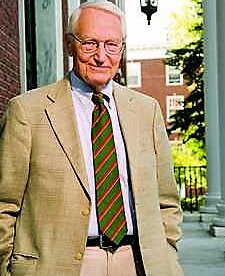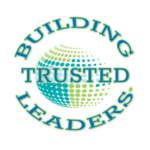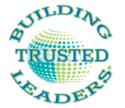
Dedicated to
Professor Paul R. Lawrence
Harvard Business School
(1922-2011)
Mentor, Friend, Colleague, Co-Author & Champion of Collaborative Leadership
Paul’s influence on the evolution of this Institute is enormous.
His work in Differentiation-Integration theory in complex organizations became the foundation of Strategic Alliance Management, from which our insights about Collaborative Leadership emerged.
His advice was on target in designing key elements of our Collaborative Innovation system.

After retirement, Paul dedicated the remainder of his life to creating an “architecture” that explained why humans do what they do. This emerged as the Four Drives of Human Behavior which then evolved as the underpinnings of our acclaimed Trust Architecture.
Paul and Robert Porter Lynch co-authored the last three articles of his life:
Paul also had two requests of me before he passed away:
First to get a book written about trust-based leadership. This request has emerged as the “Trusted to Lead” series, which is evolving as several different books on collaborative leadership.
Second, he hoped to see a Collaborative Leadership Institute formed to carry forth the vision for collaborative excellence. This Institute is a realization of that vision. Paul observed:
“It’s imperative to understand cooperative systems architecture because future leaders will either be part of a collaborative network or be competing against one. Many would have been saved from financial hardship, frustration, and even failure had they had access to this information.”
Of the numerous insights had about organizations, leadership, and human behavior, one stands out as guidance today…
“Trust Determines ….
– the Course of History
– the Destiny of Nations
– the Fate of People…..”
————————–
My relationship with Paul R. Lawrence
By Robert Porter Lynch
The Leadership Institute is founded on the principle that effective leadership is at the core of all great organizations and civilizations. But….
When leadership declines, organizations soon follow;
when organizations decline, civilizations are next.
In 1972, after serving a tour of duty in Vietnam as an officer on a fast frigate, I was assigned to Admiral Zumwalt’s special Command Development program to find better ways to shift the Navy’s thinking about leadership, men and mission. As part of our training, Professor Lawrence’s Harvard Business Review article on “New Management Role — the Integrator” (1967) was required reading. It was an intriguing idea, but at the time, I wasn’t sure how to apply his thinking.
However, having the opportunity to learn more from the best and brightest professors at Harvard and MIT gave me a powerful reason to get my Master’s Degree. I met Paul and audited his course at Harvard Business School in 1975. I recognized his teaching of Differentiation-Integration Theory was valuable and useful, but did not yet have a powerful application for it.
In 1985, when I started my search for the “Architecture of Cooperation” that culminated in the framework of Strategic Alliances (The Practical Guide to Joint Ventures & Business Alliances, Wiley, 1987) I realized that Professor Lawrence’s framework was the ideal application. He coached me and guided me, especially on the section on Managing Alliances, which, at the time no one had ever considered.
Based on skeletal anecdotal evidence we had on the issue, plus Paul’s vast knowledge of the role of integrators we were able to fill the void with wise advice that that formed a solid basis for alliance management as we know it today.
This initiative this launched several more books, plus years of Executive Educations programs around the world, and the next generation of thinking about collaboration. Our joint efforts have produced a collaborative architecture that underpins tens of thousands of alliances all across the globe.
Paul and I speculated in the late 1980s that Strategic Alliances would, if properly executed, trigger a phenomenon of Collaborative Innovation — which they did. The architecture of collaboration was powerful enough to bring differentials in thinking together in an environment of trust, that enabled rapid innovation to flourish.
However, the biggest problem encountered by both strategic alliances and collaborative innovation was the issue of TRUST — bad trust results in poor teamwork and constrains the mind’s ability to imagine beyond one’s own limits, rejecting possibilities and new paradigms from other people.
Together we initiated the development of a systems design “Architecture of Trust.” We wrote an article for the European Business Review on Leadership and the Structure of Trust and a breakthrough article for HBR — Trusted to Innovate – (which they declined to publish the week before Paul passed away). These never gained the traction they should have, but the frameworks they embody are part of my teaching and have been extremely well received. From what we realize now, these ideas were simply well ahead of their time, and are now being received with far more acclaim than when first written.
Paul’s last breakthrough was cracking the code on what “drives human behavior.” I was able to assist in determining the unique brain neuro-chemistry that underpins the four drives, and most importantly, the way the neuro-chemistry impacts trust – the foundation of all collaborative enterprise. The 4-Drive model is the foundation-stone of our entire approach to leadership.
Paul dearly knew leadership was the key leverage point for impacting the future course of business and government, and that we needed to find a way to create a Leadership Institute
As is evident in Paul’s last book Driven to Lead (Jossey Bass, 2011), one of the top issues for Paul was the BAD leadership. Together we also worked on the problems of the Dark Triad (Psychopaths, Narcissists, and Machiavellians) with Robert Hare at the University of British Columbia. Exposing and disarming such BAD leadership is one of the goals of the Institute.
Paul, in so many ways, was my “intellectual father,” and I owe an enormous debt of gratitude for his influence, which can only be repaid by multiplying and leveraging his great insights.
Together we can build an Institute that provides the right kind of learning, activation, teaching, writing, promoting, and forming alliances with like-minded institutions, so that, united, we can shift the tide of decline.
Trust in institutions around the world has plummeted at an extraordinary rate in the last decade. There could be no better time for leaders to unify our mission to build trusted leaders and change the trajectory of our future — which most wise people see in a slow, steady, and unmistakable decline.
Together, we must make good character and collaborative leadership “top of mind and center of heart” across the land by mobilizing people to action.
